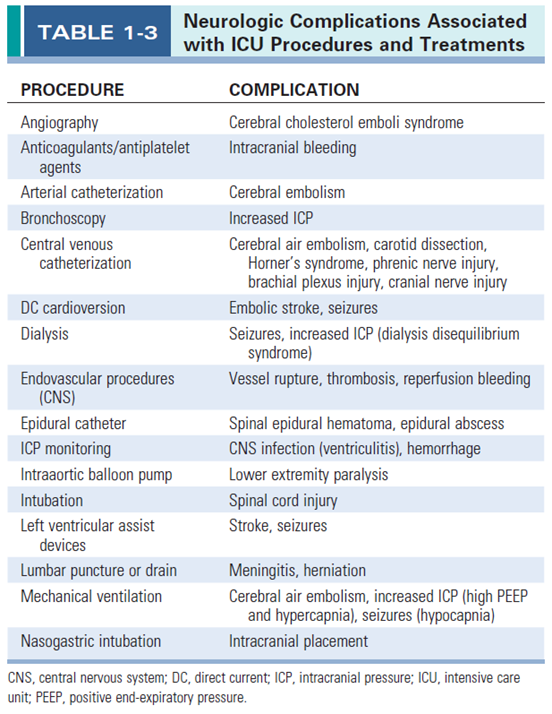Neurologic complications of procedures and treatments
중환자실에서 시행하는 일반적인 시술이나 critical illness에 대한 평가 및 치료와 관련된 시술로 인해 neurologic complication(신경학적 합병증)이 나타날 수 있다. 가장 명백한 neurologic complication은 stroke(뇌졸중) 등의 치료로 thrombolytic agents(혈전용해제)나 anticoagulants(항응고제) 투여 후 발생한 secondary intracranical bleeding(이차성 두개내 출혈)을 들 수 있다.

Evaluation of sudden neurologic change
중환자에서 neurologic condition 변화가 갑자기 나타난다면 신경학적 평가 검사, 변화 전의 임상 양상이나 약물 투약력 검토, 면밀한 혈액 검사, 적절한 영상 검사, 신경생리학적 검사 등을 시행해야 한다. 검사 방법이나 범위는 환자의 임상 양상이나 신경학적 변화의 일반적인 종류에 따라 결정할 수 있는데, 개별 환자에 대한 꼼꼼한 history taking과 physical examination이 임상 진단을 내리는데 도움이 된다.
Neurologic examination(신경학적 검사)의 필수 요소로 의식 수준과 내용, 동공의 크기와 반응 정도, 운동 기능의 평가를 들 수 있다. 평가 결과 CNS 국소 병변에 대한 증거가 없이 오직 arousal(각성) 변화만 나타난다면 감염에 대한 평가, 투여 중인 약물의 변경이나 중단, 일반적인 metabolic evaluation이 필요할 수 있다.
Lumbar puncture(요추 천자)는 일부 신경외과 환자나 면역저하 환자에서 CNS 감염 진단을 위해 시행해볼 수 있지만, 다른 환자군에서 nosocomially acquired meningitis(병원 획득 뇌수막염)를 감별하기 위해 시행하는 것은 적절하지 않다.
Electroencephalography(EEG, 뇌파검사)는 명백한 seizure의 증거가 있거나 nonconvulsive status epilepticus 가능성이 있는 경우 시행해야 하는데, nonconvulsive status epilepticus가 의심되지만 초기 EEG에서 확인되지 않은 경우 지속적인 EEG를 고려해야 한다.
Computed tomography (CT)는 새로 focal deficit이나 seizure가 발생하거나 기타 설명되지 않는 arousal 장애가 발생한 경우 시행한다. Primary neurologic disorders 환자에서 새로 focal deficit이 발생하거나 neurologic status 악화가 나타나서 brain edema, herniation, bleeding, hydrocephalus의 악화가 의심된다면 CT 촬영이 적응증이 된다.
Neurologic condition의 변화에 대한 원인이 여전히 확인되지 않는 경우라면 magnetic resonance imaging (MRI)이 도움이 될 수 있다. 특히 diffusion-weighted MRI는 일반적인 CT나 기존 MRI에서는 분명하지 않은 hypoxic brain injury(저산소성 뇌손상), fat embolism(지방 색전증), vasculitis(혈관염), cerebral venous thrombosis(대뇌정맥 혈전증), cardiopulmonary bypass 후이 multiple infarcts와 같은 구조적 이상을 진단할 수 있다. 또한 MRI는 human immunodeficiency virus (HIV) 감염이나 새로 발생한 CNS complication에서 선택할 수 있는 검사이다. Critical illness를 악화시키는 cord injury의 징후와 증상이 나타나는 경우, MRI나 somatosensory evoked potentials를 시행함으로써 injury의 특성과 중증도를 더 자세히 평가할 수 있다.
Generalized muscle weakness나 unexplained ventilatory dependency(기계 호흡 의존)을 보이는 환자의 electromyography(근전도)나 nerve conduction studies를 통해 critical illness polyneuropathy나 critical illness myopathy를 확진할 수 있다.
Monitoring or neurologic changes
중환자에서 흔하게 발생하는 신경학적 변화는 면밀한 monitoring을 필요로 한다. Glasgow Coma Scale (GCS), National Institutes of Health Stroke Scale, Ramsay Sedation Scale, Richmond Agitation-Sedation Scale (RASS), Confusion Assessment Method for the Intensive Care Unit (CAM-ICU)와 같은 다양한 임상 방법을 사용해서 clinical neurologic status를 monitoring 할 수 있다.
Bispectral index와 같은 신경생리학적 검사는 primary neurologic problem이 있거나 혹은 없는 환자에게 미래에 보다 객관적인 neurologic monitoring을 제공할 것으로 기대된다.
Primary neurologic disorder로 중환자실에 입실한 환자에 대한 평가방법으로 intracranial pressure(두개내압)의 측정, near-infrared spectroscopy, brain tissue PO2, transcranial Doppler, electroencephalography 등을 들 수 있다.
Reference
Chapter 1. Sudden Deterioration in Neurologic Status. Textbook of critical care, 7th ed. Elsevier
2024.02.08 - [의학] - Demedetomidine(precedex, medex) 용법과 부작용
Demedetomidine(precedex, medex) 용법과 부작용
Delririum(섬망), agitation(진전) 등에서 사용하는 dexmedetomidine(precedex, medex, 프리세덱스, 메덱스)의 용법과 부작용은 다음과 같다. Dosage regimen 일반적으로 initial loading dose는 하지 않지만 필요한 경우
blueorbit.tistory.com
2024.01.19 - [의학] - 섬망의 정의와 위험 인자
섬망의 정의와 위험 인자
Delirium(섬망)의 정의 1. 집중, 유지, 또는 주의를 전환하는 능력이 감소된 의식 장애(disturbance of consciousness). 즉, 주변 환경에 대한 인식의 명확성이 감소. 2. 인지(cognition) 능력의 변화(eg, memory defici
blueorbit.tistory.com
'의학' 카테고리의 다른 글
| 중환자에서 발생하는 stroke, focal neurologic deficit, seizures, generalized weakness, neuromuscular disorders (0) | 2024.04.15 |
|---|---|
| 중환자실 섬망을 예방하기 위한 야간 dexmedetomidine(precedex) 투여 용법과 결과 (0) | 2024.04.13 |
| 항생제 감수성 결과에 따라 항생제를 선택할 때 고려할 사항 (1) | 2024.04.07 |
| 항문주위 농양 , 치루 (0) | 2024.04.06 |
| 항문주위 농양, 치루에서 시행하는 seton 수술 (0) | 2024.04.06 |



